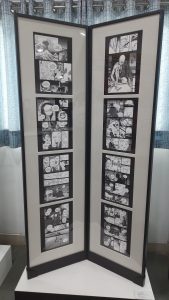The International Traveling Exhibition was organised by the Management Association (AMA) in collaboration with the Consulate-General of Japan in Mumbai to commemorate the 70th anniversary of the “Establishment of Diplomatic Relations” between Japan and India and to showcase the best of Japanese arts and culture through manga-cartoons, Ukiyo-e classic paintings, and book covers at the Japan Information and Study Centre in Ahmedabad.
The exhibition at AMA here was opened on Friday by renowned artist Amit Ambalal and Toshihiro Kaneko, Chief Consul, Consulate-General of Japan in Mumbai.
This show includes seven modern Manga artists in addition to 15 volumes of Hokusai’s works.
Mangas aid in the intellectual growth of both youngsters and adults, according to a study by The University of Tokyo.
The exhibition, also known as “MANGA HOKUSAI MANGA ART SHOW,” features contemporary works by renowned manga artists as well as Grand Master Hokusai’s exhibition of ukiyo-e classics.
Mukesh Patel, president of the Indo-Japan Friendship Association, and Deevyesh Radia, president of AMA, discussed the special cultural connection between India and Japan through such Manga masterpieces in a press conference. In Japan and India, cartoons and comics are hugely popular. Japan’s most well-known manga is called Doraemon. Mangas aid in the intellectual growth of both youngsters and adults, according a study by The University of Tokyo. The various devices that Doraemon uses in the show serve as inspiration for others to develop new scientific and technological innovations.

The goal of this exhibition is to introduce the appeal of this distinctive area of Japanese culture. The exhibits feature panels, booklets, movies, and a collection of new works by modern Manga artists, with a focus on pictorial storytelling and participatory culture of “Manga” from various eras”: Image of Mukesh Patel, President of the Northeastern Indo-Japan Friendship Association
This exhibition aims to highlight the charms of this distinctive area of Japanese culture by highlighting some of the similarities and differences between contemporary Japanese Manga, which are now extremely popular on a global scale, and Hokusai Manga, a collection of sketches by the Ukiyo-e Artist Katsushika Hokusai (1760–1849). The exhibitions feature panels, books, movies, and a collection of new works by contemporary Manga artists, with a focus on pictorial storytelling and participatory culture of “Manga” from various eras, according to Mukesh Patel, president of the Indo-Japan Friendship Association.
The visual storytelling medium known as Japanese manga has developed over time in Japan. Ancient Japanese art is where manga art finds its origins. In Japan, comics and cartooning are both referred to as manga. Manga has a history that dates back to the 12th century. The exhibition also includes pieces by Katsushika Hokusai, a pioneer of the Japanese manga genre. Japanese Ukiyo-e artist Katsushika Hokusai, also referred to as Hokusai, was active throughout the Edo period.
Ukiyo-e is defined as “images of the floating world.” The Japanese Manga movement was founded on Ukiyo-e. The Great Wave off Kanagawa by Master Hokusai and The Fifty Three Stations of the Tokaido by Artist Hiroshige both continued the tradition. Manga is a representation of everything delicate, whimsical, hilarious, mundane, and enjoyable. It creates a courageous and ground-breaking artistic entryway into a universe where the transitory is transformed into something lasting, everlasting, and artistic.
This exhibition features seven contemporary Manga artists who have revisited Hokusai’s Manga, including Ichikawa Haruko for Summer Fields, Igarashi Daisuke for A Person Who Draws the World, Kyo Machiko for Innocent Toys, Nishijima Daisuke for La Mer I, Okadaya Tetuzoh for That’s All For Now, Shiriagari Kotobuki for Funny Face 2015, and Yoko
The exhibition, which is self-explanatory, is broken up into four sections that take you through the development of manga and Hokusai’s manga. The first section of “Hokusai Manga: Funny Pictures?,” which also explains the origins of the word “Manga,” features block-printed images on 15-stitched-bound volumes. In these block-printed pictures, Hokusai’s interpretation of daily life in Japan is shown.
The second section, “A Character Named Hokusai,” features examples of various recent Mangas that used Hokusai in their stories. Kamimura Kazuo, Sugiura Hinako, Ishoinomori Shotaro, Samura Hiroaki, Sakura Sawa, and Saeki Konosuke are a few manga artists who used this.
In the third section, “Manga Like Ukiyo-e, Ukiyo-e Like Manga,” the use of balloons, symbolic lines, panelling, and eye size are examined. The playful side of Hokusai’s Manga is shown in the fourth section, “Hokusai Manga: Shared Manual!” At the exhibition’s conclusion, visitors can view a number of well-known Manga.
From January 21 to February 02, 2023, the Exhibition will be accessible to the public every day at Ahmedabad Management Association from noon to 7:00 p.m. Entry is uncharged.